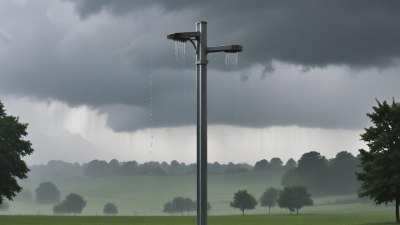Why Water Parks Are Just an Elaborate Social Experiment on Human Patience
Exploring the psychology behind water parks as a test of human patience and social interaction.

This image was created with the assistance of Freepik
Water parks have become a staple of summer entertainment, attracting families and thrill-seekers alike. But have you ever wondered why people willingly wait in seemingly endless lines for mere seconds of splashing excitement? The answer lies in a fascinating intersection of psychology, sociology, and human behavior. This article will delve into the nuances of why water parks can be considered elaborate social experiments on human patience.
The Attraction of Water Parks
Water parks offer a unique blend of relaxation and adrenaline, making them appealing to a wide audience. The sparkling blue waters, thrilling slides, and lazy rivers create an atmosphere of fun and escape from everyday life. However, the allure of these parks comes with a price: long wait times. From the moment guests arrive, they're met with lines that seem to stretch on forever. This initial inconvenience sets the stage for what can only be described as a test of patience.
The Psychology Behind Waiting
Waiting is an inherent part of the human experience, but it takes on a different dimension in a water park setting. The anticipation built during the wait can amplify the enjoyment of the activity itself. According to psychological studies, the way we perceive waiting has more to do with our mindset than the actual duration. At a water park, the excitement of what lies ahead—whether it's a high-speed slide or a relaxing float in the lazy river—can help mitigate feelings of frustration while waiting.
Social Dynamics in Lines
Queueing is also a social activity. Water parks are filled with groups of people who often interact while waiting. These interactions can range from shared comments about the length of the line to swapping stories about previous water park experiences. Such conversations cultivate a sense of community among strangers—a phenomenon sociologists refer to as 'communal waiting.' This shared emotion transforms the experience, as visitors bond over the mutual challenge of patience.
Strategies for Coping with Wait Times
Many visitors create strategies to cope with extended wait times. Some engage in games, browse their phones, or educate themselves about the rides via signage. Others might use the time to observe fellow park-goers, making light-hearted judgments about what they see. These coping mechanisms not only distract from the discomfort of waiting but also enhance the overall experience, embedding water parks deeper into our collective social memory.
The role of FOMO (Fear of Missing Out)
Fear of Missing Out (FOMO) plays a significant role in the phenomenon of waiting in water parks. As people watch others zoom down exciting slides, the desire to partake intensifies, creating a sense of urgency to endure the waiting period. Moreover, the combination of immersive social experiences and fear of missing out connects visitors, fostering an atmosphere where waiting feels almost rewarding. This social pressure ensures that people invest time in the experience, an invaluable part of the water park ritual.
The Role of Discounts and Promotions
Marketing strategies employed by water parks further contribute to this experiment on patience. Discount days and promotions often lead to larger crowds, making wait times even more prominent. This marketing tactic plays into people's willingness to wait for a deal, often leading to an interesting interplay between savings and satisfaction. After all, toughing it out in lines for discounted tickets may cultivate a sense of accomplishment, enabling guests to justify their long wait times.
Management Strategies: Embracing the Wait
Water park management has acknowledged that wait times are an essential part of the visitor experience. Many parks have implemented strategies to make the waiting experience more enjoyable, such as offering interactive queues where guests can engage with games or information about the rides. Some parks utilize technology to keep visitors informed about wait times and slide popularity in real-time, enabling guests to make informed decisions about their next adventure. These tactics transform waiting from a mere inconvenience into a curated part of the overall experience.
Patience and Personal Growth
On an individual level, the act of waiting can also promote personal growth. Spending time in line can serve as a moment of reflection, allowing guests to contemplate life outside the water park's rollercoaster of excitement. In an increasingly fast-paced world, these opportunities for pause are becoming scarce, rendering waiting in line a potentially valuable experience. For many, the time spent waiting for their turn on a ride acts as a microcosm of larger life lessons in patience, resilience, and gratitude.
Parental Perspective on Waiting
For parents, waiting in water parks also takes on a unique significance. Many parents encourage their children to embrace the waiting period as a lesson in patience and self-control. The dynamic here is multifaceted: children learn from their parents' behavior while parents instill values of waiting and perseverance in their kids. This transmission of patience can have lasting impacts on children’s emotional intelligence and ability to manage expectations in various life scenarios.
Examining Water Park Social Norms
The acceptable behaviors exhibited in water parks create a unique set of social norms. These norms dictate how individuals respond to waiting, including the etiquette of line-cutting and how noise levels fluctuate as anticipation builds. Breaking these norms can lead to social repercussions, making guests mindful of their behavior while waiting. As such, water parks serve as a living laboratory for studying human social behavior in action.
The Experience of Thalassophobia
Interestingly, while many enjoy the excitement of water parks, some harbor a fear of water known as thalassophobia. This fear can influence how individuals engage with water parks, resulting in different experiences of waiting. For a thalassophobic individual, the anticipation attached to getting into the water is filled with anxiety rather than excitement, complicating their relationship with the overall experience. Such variations in emotional response add another layer to the social experiment at hand, showcasing the diverse range of human interactions in a single locale.
Technological Advances in Wait Management
The advent of technology has also revolutionized how water parks manage wait times. Mobile apps now allow visitors to reserve slots for rides, reducing the anxiety associated with long queues. This innovation elevates the waiting experience, allowing guests to spend their time enjoying amenities, rather than standing in line. These advancements further illustrate how water parks adapt their models to optimize both fun and feasibility.
Water Parks as a Cultural Phenomenon
Internationally, water parks are influenced by various cultural perceptions of fun and leisure. In some cultures, water parks represent adventurous family bonding experiences; in others, they symbolize potential safety hazards that necessitate caution. This dichotomy shapes how individuals approach waiting and interaction within parks, highlighting the broader sociocultural contexts that inform personal experiences with leisure activities.
The Future of Water Parks
This exploration of water parks as social experiments on patience reveals much about human nature. The intricate tapestry woven from waiting, social dynamics, and individual experience creates a unique cultural phenomenon. As technology evolves, and our understanding of social interactions deepens, water parks will likely continue serving as testing grounds for human patience and social connections, inviting both new challenges and opportunities for growth. For now, as visitors face those long and winding lines, they do so knowing that every moment of waiting is a part of a much larger experience—one that tests both their patience and their ability to connect with others in a shared pursuit of joy.











